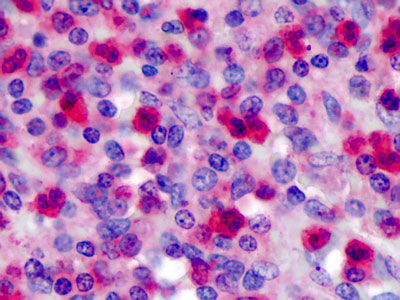FPR1 / FPR Antibody (aa155-204)
Rabbit Polyclonal Antibody
- SPECIFICATION
- CITATIONS
- PROTOCOLS
- BACKGROUND

Application
| WB, IHC-P, IF, E |
|---|---|
| Primary Accession | P21462 |
| Reactivity | Human |
| Host | Rabbit |
| Clonality | Polyclonal |
| Calculated MW | 38kDa |
| Dilution | ELISA (1:1000), IF (1:100-1:500), IHC-P (5 µg/ml), WB (1:500-1:1000) , |
| Gene ID | 2357 |
|---|---|
| Other Names | fMet-Leu-Phe receptor, fMLP receptor, N-formyl peptide receptor, FPR, N-formylpeptide chemoattractant receptor, FPR1 |
| Target/Specificity | FPR1 Antibody detects endogenous levels of total FPR1 protein. |
| Reconstitution & Storage | Store at -20°C for up to one year. |
| Precautions | FPR1 / FPR Antibody (aa155-204) is for research use only and not for use in diagnostic or therapeutic procedures. |
| Name | FPR1 |
|---|---|
| Function | High affinity receptor for N-formyl-methionyl peptides (fMLP), which are powerful neutrophil chemotactic factors (PubMed:10514456, PubMed:15153520, PubMed:2161213, PubMed:2176894). Binding of fMLP to the receptor stimulates intracellular calcium mobilization and superoxide anion release (PubMed:15153520, PubMed:15210802, PubMed:1712023, PubMed:2161213). This response is mediated via a G-protein that activates a phosphatidylinositol-calcium second messenger system (PubMed:10514456, PubMed:1712023). Receptor for TAFA4, mediates its effects on chemoattracting macrophages, promoting phagocytosis and increasing ROS release (PubMed:25109685). Receptor for cathepsin CTSG, leading to increased phagocyte chemotaxis (PubMed:15210802). |
| Cellular Location | Cell membrane; Multi-pass membrane protein. Note=Internalizes in presence of its ligands, fMLP, TAFA4 and CTSG. |
| Tissue Location | Neutrophils. |
| Volume | 50 µl |

Thousands of laboratories across the world have published research that depended on the performance of antibodies from Abcepta to advance their research. Check out links to articles that cite our products in major peer-reviewed journals, organized by research category.
info@abcepta.com, and receive a free "I Love Antibodies" mug.
Provided below are standard protocols that you may find useful for product applications.
Background
High affinity receptor for N-formyl-methionyl peptides (fMLP), which are powerful neutrophil chemotactic factors (PubMed:2161213, PubMed:2176894, PubMed:10514456, PubMed:15153520). Binding of fMLP to the receptor stimulates intracellular calcium mobilization and superoxide anion release (PubMed:2161213, PubMed:1712023, PubMed:15153520). This response is mediated via a G-protein that activates a phosphatidylinositol- calcium second messenger system (PubMed:1712023, PubMed:10514456).
References
Boulay F.,et al.Biochem. Biophys. Res. Commun. 168:1103-1109(1990).
Boulay F.,et al.Biochemistry 29:11123-11133(1990).
Murphy P.M.,et al.J. Biol. Chem. 266:12560-12567(1991).
Bao L.,et al.Genomics 13:437-440(1992).
Perez H.D.,et al.Submitted (MAR-1993) to the EMBL/GenBank/DDBJ databases.
If you have used an Abcepta product and would like to share how it has performed, please click on the "Submit Review" button and provide the requested information. Our staff will examine and post your review and contact you if needed.
If you have any additional inquiries please email technical services at tech@abcepta.com.













 Foundational characteristics of cancer include proliferation, angiogenesis, migration, evasion of apoptosis, and cellular immortality. Find key markers for these cellular processes and antibodies to detect them.
Foundational characteristics of cancer include proliferation, angiogenesis, migration, evasion of apoptosis, and cellular immortality. Find key markers for these cellular processes and antibodies to detect them. The SUMOplot™ Analysis Program predicts and scores sumoylation sites in your protein. SUMOylation is a post-translational modification involved in various cellular processes, such as nuclear-cytosolic transport, transcriptional regulation, apoptosis, protein stability, response to stress, and progression through the cell cycle.
The SUMOplot™ Analysis Program predicts and scores sumoylation sites in your protein. SUMOylation is a post-translational modification involved in various cellular processes, such as nuclear-cytosolic transport, transcriptional regulation, apoptosis, protein stability, response to stress, and progression through the cell cycle. The Autophagy Receptor Motif Plotter predicts and scores autophagy receptor binding sites in your protein. Identifying proteins connected to this pathway is critical to understanding the role of autophagy in physiological as well as pathological processes such as development, differentiation, neurodegenerative diseases, stress, infection, and cancer.
The Autophagy Receptor Motif Plotter predicts and scores autophagy receptor binding sites in your protein. Identifying proteins connected to this pathway is critical to understanding the role of autophagy in physiological as well as pathological processes such as development, differentiation, neurodegenerative diseases, stress, infection, and cancer.




